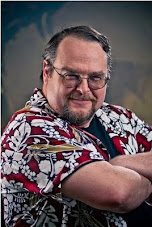 Flash Fact: I've never read the Harry Potter books. Nope, that's true. My exposure to that universe consists of the movies and what I pick up on street corners. The Lovely Bride HAS read all of them, so our movie-going experience often consists of later debriefs where she explains all the back story of characters that seem important but we only see them briefly in the film. I am good with that.
Flash Fact: I've never read the Harry Potter books. Nope, that's true. My exposure to that universe consists of the movies and what I pick up on street corners. The Lovely Bride HAS read all of them, so our movie-going experience often consists of later debriefs where she explains all the back story of characters that seem important but we only see them briefly in the film. I am good with that.Similarly, Henrik Ibsen. I know, I am a barbarian to have avoided both Ibsen and Rowling, but such is my lot in life. But the Lovely B went through an Ibsen phase in her youth, and understood a lot of what Henrik Ibsen meant for both theater and Western Civilization in general. So I turned to her as a guide, and she gave me the skinny on A Doll's House, The Original Edition.
Previously, on A Doll's House: Nora is married to Torvald and has perfect marriage, except it isn't. Rather it is filled with the smell self-denials and misrepresentations that a lot of marriages have. When Torvald is ill and can only be cured by sending him away on a trip that Torvald refuses to pay for, Nora forges his name on documents to borrow the money in order to save him. He recovers, he finds out, and is angry at Nora for the deception (you know, for Saving His Life). The situation is resolved, but Nora says to hell with the relationship, give me a divorce, I'm out of here. And she leaves, closing the door on her previous life, her husband, and her children.
And this was radical back in the day (we're talking 1879 or so). The audience expected the problem set forth in the play to be resolved and with it a return to normalcy. And they also didn't expect to see the subordinate position of women in the relationship laid so bare. And this is why Ibsen is remembered.
Yet, you have the challenge of "What happened next?" We had a resolution but, what happened next? What happened to Torvald? And Nora? And the kids? Inquiring minds what to know. Maybe there's a happy ending?
But if you wait long enough, no story ever has a happy ending.
Anyway, in the new production, it is fifteen years later, Nora's back. Not crawling, but successful. Her choice has given her a full life. But because of unfinished business with Torvald, she has to confront him again and hash over the relationship again. And the result like being with that old married couple that is always bickering. You know what they are going to say. They know what they are going to say It is sort of. Who's Afraid of Virginia Wolfe with less abusive partners (because they're Scandinavian. Did I mention that? Yeah, we're in Norway. So we are SO reserved.)
The play pamphlet states you don't need to know about the first play (though it does repeat the final page of the original), and that is true. There is a lot of hashing and rehashing going on, and what people thought, or thought they thought, back then. Time does not heal wounds, and now as a result Nora is another situation of fraudulent documents (Scandinavians, regardless of the era, seem to have a great belief in contracts). And the deck is still stacked against women in general and Nora in particular.
And there is a lot of lecturing. Indeed, the actors are confined to two roles - lecturing and being lectured to. From all sides. The four actors involved are all excellent at their craft, but there is precious little to work with, here. Stoic is a very Scandinavian trait, and the actors might as well be furniture when they aren't delivering their lines.
There is no sense of dread or creeping doom that (I have heard) populates Ibsennic theatre present in Part Two. There is a problem, there are attempts to resolve it. Actually, while the play gives me nothing, the set design this time tries to embrace an idea of discomfort - a stark, uneven corner of a grand house, presented at an angle, filled with absent furnishings and only a few chairs. The walls are a yellowish tinge that can usually be found in new housing developments in Seattle, which makes you uneasy. It feels like they belong to a different play entirely.
Ultimately, the question for me is if ADHp2 could exist on its own, without its noted ancestor hanging over the proceedings. Even though it does its best to fill in the bits from the earlier edition, it feels a bit empty. The characters don't seem to move, and we spend a great deal of time catching up on the last 15 years. If you are going to claim descent, then you ask for comparison, and I don't see the 2nd edition creating the stir, political and personal, that the first one did. We really didn't need to know how it all turned out.
More later,









